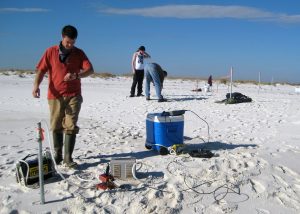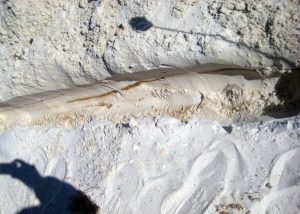Study Models Oil Aerobic Biodegradation Rates in Tidal Beaches
– MAY 19, 2016
A team of scientists created a numerical model that simulates hydrocarbon biodegradation and transport in tidally influenced beaches to identify key factors affecting biodegradation in these environments.
They found that several limiting factors, including tidal stages, oxygen and nutrient concentrations, and groundwater seepage into the water column significantly affected modeled biodegradation rates in these areas. They published their findings in Water Resources Research: Biodegradation of subsurface oil in a tidally influenced sand beach: Impact of hydraulics and interaction with pore water chemistry.
Modeling microbial oil degradation can help predict long-term oil fate within sediments. Researchers coupled biological kinetic models and flow models to create the numerical model BIOMARUN, which could account for factors such as oxygen and nutrient consumption and water salinity on water flow. They used this model to recreate realistic beach and tide conditions and simulate the biodegradation of low-solubility hydrocarbons in tidally influenced beach environments. This study is the first to relate biodegradation rates with pore water movement and environmental conditions in various areas of the beach.
Model simulations revealed that different limiting factors affected biodegradation rates in different portions of the beach. Nutrient concentration was the limiting factor in the upper intertidal zone, as relatively large oxygen concentrations resulted in biodegradation rates that increased with depth due to increased nutrient concentration with depth. However, oxygen concentration was the limiting factor in the mid-intertidal zone, as nutrient concentrations were relatively constant, resulting in biodegradation rates that depended primarily on oxygen concentration.
Study author Michel Boufadel explained, “These findings are contrary to the common assumption that a single factor influences biodegradation across an entire beach. This means, for example, that increasing the nutrient concentration would not always enhance oil biodegradation throughout the beach.”
Researchers observed that oxygen concentration in the mid-intertidal zone peaked at two different times: when oxygen-laden seawater entered the beach environment during high tide and when the atmosphere replenished oxygen during low tide. The team also noted that a large water content above the water table, known as the capillary fringe, could impede biodegradation rates; oxygen replenishment was limited when the capillary fringe was too high, but a too low capillary fringe reduced the interactions between microorganisms and oil.
The researchers noted that it is unlikely denitrification affected oil biodegradation in this system but should be investigated along with other chemical processes to determine its potential as a limiting factor. Because tidally influenced beaches are highly dynamic and exhibit complex mixing between water from various sources, the researchers hope that their model will help account for transport and processes stemming from tides. Boufadel stated, “The developed model BIOMARUN has been validated to various data sets and allows one to predict the persistence of oil in various compartments of the beach. Measuring the oil concentration and microbial community at a specific location and time on a beach might not reflect the overall behavior of oil in beach systems. Therefore, one needs models such as BIOMARUN to generalize the results.”
The study’s authors are Xiaolong Geng, Michel C. Boufadel, Kenneth Lee, Stewart Abrams, and Makram Suidan.
************
This research was made possible in part by a grant from the Gulf of Mexico Research Initiative (GoMRI) to the Consortium for Advanced Research on Transport of Hydrocarbon in the Environment II (CARTHE II). Other funding sources included the National Science Foundation (CBET-1313185).
The Gulf of Mexico Research Initiative (GoMRI) is a 10-year independent research program established to study the effect, and the potential associated impact, of hydrocarbon releases on the environment and public health, as well as to develop improved spill mitigation, oil detection, characterization and remediation technologies. An independent and academic 20-member Research Board makes the funding and research direction decisions to ensure the intellectual quality, effectiveness and academic independence of the GoMRI research. All research data, findings and publications will be made publicly available. The program was established through a $500 million financial commitment from BP. For more information, visit https://gulfresearchinitiative.org/.
© Copyright 2010- 2017 Gulf of Mexico Research Initiative (GoMRI) – All Rights Reserved. Redistribution is encouraged with acknowledgement to the Gulf of Mexico Research Initiative (GoMRI). Please credit images and/or videos as done in each article. Questions? Contact web-content editor Nilde “Maggie” Dannreuther, Northern Gulf Institute, Mississippi State University (maggied@ngi.msstate.edu).







